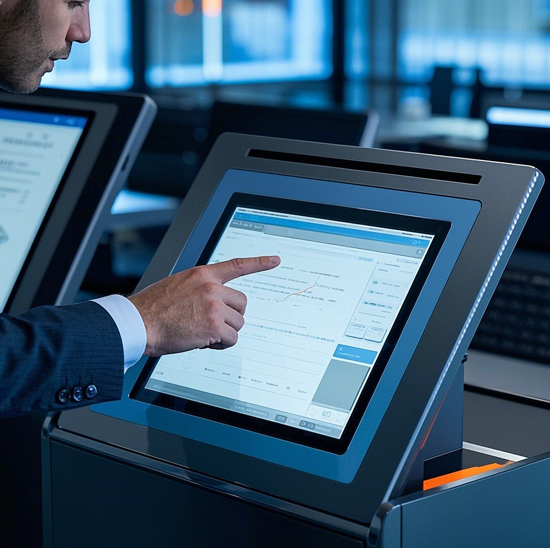In the interconnected world of global manufacturing, the Industrial Touch Interface serves as the critical link between human operators and automated systems—from automotive plants in Europe to electronics factories in Asia. Choosing the right supplier for these interfaces is more than a procurement decision; it directly impacts production reliability, supply chain resilience, and long-term cost efficiency. With thousands of suppliers worldwide, each claiming expertise in industrial touch technology, global manufacturers face the challenge of identifying partners who can meet diverse regional standards, deliver consistent quality, and adapt to evolving production needs. This guide breaks down the key criteria for evaluating Industrial Touch Interface suppliers, highlights top regional players, and addresses common sourcing questions to help global manufacturers make informed partnerships.

Key Criteria for Evaluating Industrial Touch Interface Suppliers
Not all suppliers are equipped to serve global manufacturing needs. Use these criteria to filter and select reliable partners:
1. Technical Expertise and Customization Capabilities
Global manufacturers often require Industrial Touch Interfaces tailored to unique workflows (Z.B., high-temperature resistance for foundries or anti-glare screens for outdoor factories). Top suppliers should:
Offer in-house engineering teams to design custom interfaces (Z.B., integrating specific ports, screen sizes, or touch technologies like infrared or capacitive).
Have a track record of solving industry-specific challenges (Z.B., providing explosion-proof interfaces for chemical plants).
Share case studies of working with manufacturers in your sector (Automobil, aerospace, consumer goods, usw.).
2. Global Supply Chain and Local Support
For multinational manufacturers, a supplier’s ability to deliver across regions and provide on-the-ground support is critical:
Check for regional warehouses or distribution centers (Z.B., a supplier with hubs in Southeast Asia, Europe, and North America can reduce shipping times and costs).
Ensure 24/7 technical support with multilingual teams (to address issues in time zones across your global facilities).
Verify compliance with regional regulations (Z.B., CE marking for Europe, UL certification for North America, RoHS for environmental standards).
3. Quality Control and Reliability
Industrial Touch Interfaces in global manufacturing must perform consistently across diverse environments. Suppliers should:
Adopt strict quality management systems (ISO 9001 is a minimum; look for ISO 13485 for medical manufacturing or IATF 16949 for automotive).
Provide detailed test reports (Z.B., vibration resistance per IEC 60068-2-6, temperature tolerance data).
Offer warranties of at least 2–3 years (with options to extend) to cover defects in materials or workmanship.
4. Scalability and Lead Time Flexibility
Global manufacturers need suppliers who can adapt to fluctuating demand:
Inquire about production capacity (Z.B., can they scale from 100 Zu 10,000 units per month?).
Ask for average lead times for standard and custom orders (ideally 4–6 weeks for standard, 8–12 weeks for custom).
Check if they offer “just-in-time” (JIT) delivery to align with your production schedules and reduce inventory costs.
Top Regional Industrial Touch Interface Suppliers for Global Manufacturing
Different regions excel in specific areas—here’s how to leverage regional strengths:
1. Asia-Pacific: Cost-Effective Mass Production
Asia-Pacific dominates Industrial Touch Interface manufacturing, with suppliers in China, South Korea, and Taiwan offering:
Competitive pricing for high-volume orders (ideal for consumer electronics or automotive parts manufacturers).
Fast turnaround for standard models (2–4 weeks for bulk orders).
Key players: Companies like Advantech (Taiwan) specialize in rugged interfaces for industrial automation, while China’s Kinco focuses on cost-friendly solutions for small to mid-size factories.
2. Europe: Precision and Compliance
European suppliers are known for strict quality and adherence to regional standards:
Expertise in custom interfaces for regulated industries (Z.B., medical devices, aerospace).
Strong focus on sustainability (Z.B., using recycled materials, energy-efficient production).
Key players: Siemens (Germany) offers integrated HMI-touch solutions, while Beckhoff (Germany) specializes in modular interfaces for smart factories.
3. Nordamerika: Innovation and Local Support
North American suppliers prioritize technical innovation and rapid service:
Cutting-edge technologies (Z.B., multi-touch industrial screens, IoT-enabled interfaces for real-time data analytics).
Local engineering support and quick replacement services (critical for minimizing downtime in U.S. or Canadian plants).
Key players: Rockwell Automation (U.S.) integrates touch interfaces with their control systems, while 3M (U.S.) offers durable touch sensors for harsh environments.
FAQs About Industrial Touch Interface Suppliers
Q1: How do we ensure a supplier can meet our global manufacturing standards across different regions?
A1: Request a “supplier audit” to review their quality processes, regional certifications, and local support networks. Many top suppliers allow virtual or on-site audits to verify compliance.
Q2: What’s the difference between a “manufacturer” and a “distributor” of Industrial Touch Interfaces?
A2: Manufacturers design and produce interfaces in-house (better for customization and quality control).
Distributors resell products from multiple manufacturers (useful for sourcing diverse models but may have higher costs).
Q3: Can a single supplier handle all our global facilities, or should we work with regional suppliers?
A3: It depends on your needs. A global manufacturer with regional hubs can simplify procurement, but regional suppliers may offer better pricing or faster support in specific areas. Many companies use a hybrid approach (one primary global supplier + regional backups).
Q4: How do we compare costs between suppliers in different regions?
A4: Look beyond unit price—factor in shipping, import taxes, warranty costs, and support fees. Zum Beispiel, a low-cost Asian supplier may have higher shipping fees to Europe than a local European supplier.
Selecting the right Industrial Touch Interface supplier is a cornerstone of successful global manufacturing. By prioritizing technical expertise, global reach, Qualität, and scalability, you can partner with suppliers who not only meet your current needs but also adapt to future challenges—whether expanding into new regions or adopting smart factory technologies.
If you’re struggling to identify the best Industrial Touch Interface suppliers for your global manufacturing network (Z.B., need help comparing regional options, verifying certifications, or negotiating scalable contracts), Füllen Sie das Formular auf unserer Website aus. Our sourcing experts will analyze your production locations, industry requirements, and budget to recommend a shortlist of qualified suppliers—helping you streamline procurement and build resilient partnerships.

